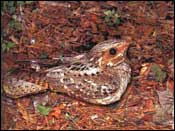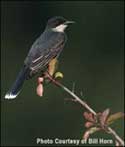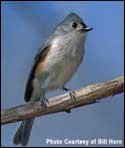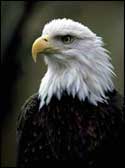The Guide to
Austin-area Birding Sites
Good places to see birds in and around Austin
Southeast Areas

8. McKinney
Falls State Park -
5808 McKinney Falls Parkway,
Austin TX 78744, (512)
243-1643
Location: From the U.S.
Highway 183/Texas Highway
71 junction, go south
on U.S. 183 for 4.3 miles
to the intersection with
FM 812 (Dee Gabriel Collins
Dr., formerly known as
Scenic Loop). Turn right
(west) onto FM 812 and
follow it for 2.2 miles
to McKinney Falls Parkway.
Turn right (north) onto
McKinney Falls Parkway
and follow it 0.4 mile
to the Park entrance,
on the left.
Habitats: A mixture of
Edwards Plateau and Blackland
Prairie ecosystems--wooded
zones interspersed with
grassland. Riparian corridor
along Onion Creek, where
migrants often congregate
(among them such locally
rare to uncommon species
as Olive-sided and Yellow-bellied
flycatchers, Gray-cheeked
Thrush, Gray
Catbird,
Philadelphia
Vireo, and
Mourning
Warbler). Barred
Owls and Chuck-will’s-widows nest near the Creek. During
spring migration, the
Park is often excellent
for warblers – as
many as 13 species have
been seen in a day (including
such local rarities as
Cerulean and MacGillivray’s
warblers). Onion Creek
sometimes hosts a Green
Kingfisher or two, especially
during fall. American
Woodcock have been reported
during winter in wet,
heavily vegetated areas.
Facilities: Visitors’ center,
map, trails (some of them
wheelchair accessible),
naturalist programs, bird
sightings log, restrooms,
water fountains, picnic
area; also camping and
swimming. Bird checklist
available. Entrance fee.
Often crowded on weekends.

9. Richard Moya County Park -
(512) 473-9437 (General
number for Travis County
parks)
Location: From the U.S.
Highway 183/Texas Highway
71 junction, go south on
Highway 183 for 2.6 miles
to the intersection with
Burleson Rd. Turn left (east)
onto Burleson Rd. and follow
it for 1.2 mile or 1.6 mile
to either of the two park
entrances (both of them
on the right). The area
accessed via the second
entrance usually has more
birds.
Habitat: Riparian woodland
along Onion Creek. Also
Pecan orchards. Good for
landbirds during spring
migration (up to a dozen
warbler species have been
seen in a day). Possibly
the most reliable spot in
Austin for the always-elusive
Barn
Owl (breeds). Eastern
Kingbird, an uncommon breeder
in the Austin area, also
nests here. Up to 10 sparrow
species have been observed
in early March; Swamp
Sparrows sometimes overwinter.
Facililties: Trails (wheelchair
accessible), restrooms,
water fountains, picnic
areas. Often crowded on
weekends. The Park opens
at 8 a.m. from May 1 to
September 9; at 9 a.m. the
rest of the year.
Further
Exploration: Southeast
Metro Park, farther downstream
along Onion Creek, is scheduled
to open in November 1999.
Nature trails and an observation
blind are planned. Call
the number given above for
more information.

10. McKinney
Roughs Environmental Learning
Center -
1884 State Highway 71 West,
Cedar Creek TX 78612,
(512) 303-5073
Location: From the main
entrance to Austin-Bergstrom
International Airport, go
east on Texas Highway 71
for 13.8 miles. The entrance
to McKinney Roughs will
be on the left.
Habitats: Contains some
of the westernmost natural
stands of Loblolly Pine.
Also Post Oak, Blackland
Prairie, and riparian woodland
ecosystems. McKinney Roughs
is within the narrow zone
of intergradation of the
Eastern and Black-crested
forms of the Tufted
Titmouse;
the resident birds found
here show a blend of characteristics
of both parental forms and
are sometimes called “Brown-crested” Titmice.
Common
Ground-Doves are
sometimes encountered along
the trails. During nesting
season, the riparian area
hosts Northern
Parulas and
Hooded
Warblers.
Facilities: Environmental
programs, learning and visitors’ centers
with restrooms and water
fountains, map, trails (some
of them wheelchair accessible).
Naturally Curious bookstore
(512) 303-5073, extension
8032. Bird checklist available.
Entrance fee.

11. Bastrop State Park and Buescher State Park -
Bastrop State Park: P.O. Box
518, Bastrop TX 78602, (512)
321-2101 Buescher State
Park: P.O. Box 75, Smithville
TX 78957, (512) 237-2241
Location: To get to Bastrop
State Park: From the main
entrance to Austin-Bergstrom
International Airport, go
east on Texas Highway 71 for
24.9 miles. Turn left (north)
at the intersection with Loop
150/Texas Highway 21, and
follow Loop 150/Texas 21 for
0.8 mile to the Park entrance.
To get to Buescher (pronounced “Bisher”)
State
Park via Texas Highway
71/95: From the Bastrop State
Park entrance, turn left (south)
onto Loop 150/Texas Highway
21 and follow it 0.8 mile
to the intersection with Texas
71/95. Turn left (east) onto
Texas 71/95 and follow it
to the exit for Buescher State
Park. Following this route,
it’s 10.2 miles from
the Bastrop State Park entrance
to the entrance of Buescher
State Park. Or: Follow Park
Rd. 1 east from Bastrop State
Park for 6.2 miles.
Habitats: Bastrop State Park
contains many of the “lost
pines” – Loblolly
Pines isolated far to the
west of the species’ main
range. Pine
Warblers are common
year round. Generally not
so common are several other
birds of the southeastern
woodlands, such as Pileated
Woodpecker. In winter, this
is the best area in the Austin
region to seek Red-breasted
Nuthatches (not present every
year). Buescher State Park,
connected to Bastrop State
Park by the winding Park Rd.
1, contains fewer pines and
more oaks. During the nesting
season, look for Northern
Parulas in areas where there
is Spanish Moss. Alum Creek,
on Park Rd. 1 approximately
midway between the two parks,
has attracted locally uncommon
birds over the years; nesting
species in this area include
Hooded and Kentucky
warblers.
The sandy soils of Bastrop
State Park constitute the
largest protected area for
the endangered Houston Toad,
most readily observed during
its mating season in early
spring; other toad species
are also found here.
Facilities: Visitors’ center,
maps, trails, restrooms, water
fountains, picnic areas. Also
cabins, camping, showers,
swimming. A bird checklist
(which includes reports from
Lake Bastrop) is available.
The entrance fee for one park
allows entrance to the other.
Further
exploration: The parks
on Lake Bastrop are worth
a visit, especially during
winter. To get to the South
Shore Park from the Bastrop
State Park entrance: Turn
right and then immediately
right (east) again onto Texas
Highway 21. Go east on Texas
21 for 1.1 mile to the flashing
light at South Shore Rd. Turn
left (north) onto South Shore
Rd. and follow it for 1.4
mile to the Park entrance
on the right.
To reach the North
Shore Park from
the Bastrop State Park entrance:
Turn right and then immediately
left (west) onto Loop 150/Texas
Highway 21. Follow Loop 150/Texas
21 for 0.8 mile to the intersection
with Texas Highway 95. Turn
right (north) onto Texas 95
and follow it 3.4 miles to
the intersection with FM 1441.
Turn right (east) onto FM
1441 and follow it 2.5 miles
to the Park entrance, on the
right. Both parks provide
views of Lake Bastrop, which
hosts thousands of American
Coots and other waterbirds
during winter. Ospreys are
usually conspicuous in winter;
Bald
Eagles are sometimes
present. Wintering landbirds
such as Ruby-crowned
Kinglet and Yellow-rumped
Warblerare often
abundant. Rarities have included Blue-footed
Booby (once!). Both
parks have restrooms, water
fountains, and picnic areas;
the South Shore Park also
has camping. Entrance fee.
For more information, call
(512) 303-7666.
Austin-area Birding Sites
Texas Parks and Wildlife Department
4200 Smith School Road
Austin, TX 78744
or send a message to: nature@tpwd.texas.gov